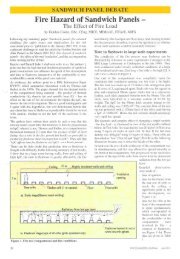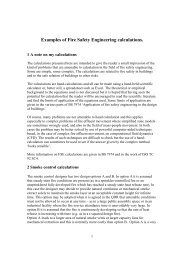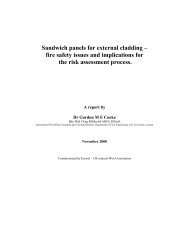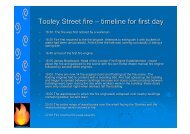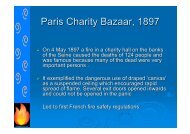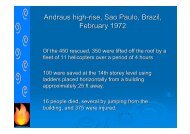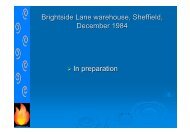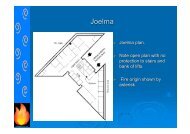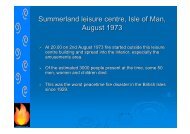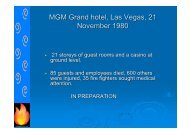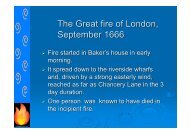Woolworth's retail store, Manchester, May 1979 - Cooke On Fire
Woolworth's retail store, Manchester, May 1979 - Cooke On Fire
Woolworth's retail store, Manchester, May 1979 - Cooke On Fire
You also want an ePaper? Increase the reach of your titles
YUMPU automatically turns print PDFs into web optimized ePapers that Google loves.
Woolworth’s s <strong>retail</strong> <strong>store</strong>, <strong>Manchester</strong>,<strong>May</strong> <strong>1979</strong>‣ 10 deaths due to smoke inhalation
Woolworth’s – building plan‣ First floor planshows location ofbodiessurprisingly closeto escape stair.Restaurant‣ Note restaurantcentre left,escalator incentre and 3 well-positionedescape stairs.‣ Too muchfurniture ondisplay - mostshould have beenin a fire resistingroom.Courtesy CACFOA
Woolworth’s – fire spreadIt is thought that fire spread was so rapid and the polyurethane(PU) fire gases were so lethal that people close to the floor exitscould not get out in time.
Woolworth’s – the buildingSS‣ The building was equipped with amains-fed fire alarm having alarm bellsand break-call points on each floor.ES‣ The self service restaurant on thesecond floor could seat 208 people butat the time of the fire there were 70 to100 people on the floor of the <strong>store</strong>.‣ The <strong>store</strong> was built in 1929 andcomprised 8 floors including 2basements. It was 42 m x 35 min plan and was steel framedwith concrete floors and concretestairways.‣ The stairways (S) were wellpositioned for means of escape.A centrally placed escalator (E)communicated with severalfloors.‣ The shop operated without a firecertificate required under thelegislation, though slow progress wasbeing made to get one.‣ At the time, the legislation did notrequire upholstered furniture to have alow flammability - this was requiredlater in 1980.‣ There were no sprinklers and nonewere required for life safety purposes.
Woolworth’s – the fire‣ The fire occurred on 8 <strong>May</strong> <strong>1979</strong>. It started near a wardrobe inthe furniture display area between 13.20 and 13.25.‣ The floor manager shouted to office staff there was a fire butthe telephonist thought he said there was a fight. (There wasno trace of a call to the fire brigade from the <strong>store</strong> at any time).‣ Diners were asked to evacuate but were reluctant as they wereeating and perhaps because they could not see the firebecause of a 1.7 m high screen around parts of the restaurant.‣ The floor manager tried to fight the fire with a hose reel withlittle effect. When the alarm was raised the sounders operatedfor only 3 to 4 minutes – it appeared that local failure of a callpoint due to heat from a fire would prevent the rest of thealarms from operating.‣ The fire brigade arrived at 13.31
Woolworth’s – the fire‣ Women could be seen behind barred windows on thesecond floor and people in an office there were rescued bythe fire brigade who had to cut the bars and help them downthe ladders.‣ 27 people were rescued by the fire brigade, 6 led to safety,and some people were rescued from the roof.‣ The fire caused the loss of ten lives primarily by inhalationof smoke and toxic gases.‣ Eye witnesses reported very rapid growth of fire and largeamounts of thick, choking smoke. There were fourindependent escape routes – three staircases and a centralescalator. Victims were found very close to, but not in, theprotected escape routes.‣ Reasons for the rapid spread of fire in single and multipleitems of plastic-upholstered furniture were investigated byBRE <strong>Fire</strong> Research Station to determine ease of ignitionand rate of heat release.
Woolworth’s – BRE heat release tests‣ After small scale tests, a 5 m x 12 m by 3 m high testcompartment with one end open for ventilation wasconstructed and instrumented by BRE to investigate fire in astacked furniture arrangement which was representative ofthe conditions in the <strong>store</strong>.‣ The test furniture included timber-based based dressing units,wardrobes, kitchen chairs, and polyurethane foamupholstered settees and mattresses, all in their packagingmaterials as in the <strong>store</strong>.‣ Mass loss was measured using a 2.5 m square load cellplatform.‣ The calculated heat output at 2.5 minutes reached a peak of23MW.
Woolworth’s – BRE heat release tests‣ Even with the fire limited to a furniture area of 3 m x 3 m, theexperiment indicated that a discharge of about 1700 m3/min(at 800 degC) ) of very dense and toxic smoke may havebeen present 2 minutes after ignition by a match.‣ In a further minute this toxic smoke is likely to have formed alayer under the ceiling over the majority of the compartmentfloor, with mixing and cooling bringing the smoke down tofloor level at the boundary walls
Woolworth’s – BRE sprinkler tests‣ Tests were made to see ifsprinklers would control such afire.‣ Even though earlier tests withsprinklers suggested that thewater discharge densityneeded for vertically stackedpolyurethane foam would betoo high to provide, a sprinklersystem would at least causean alarm to be raised.‣ In the BRE large scalesimulation, bulbs in the mock-up sprinkler installation (whichintentionally did not containwater) operated within 30seconds of ignition.‣ BRE made three sprinklertests using a sprinkler systemwith 5 mm, 10 mm and lastly2.3 mm/minute discharge..‣ In the first two tests the smoke turnedwhite and descended to floor level, butthe volume of smoke was markedlyless than in the unsprinklered test.‣ With 2.3 mm/minute discharge the firewas not extinguished and producedsmoke and gases of appreciablygreater volume than in the other twosprinklered tests.‣ The sprinkler tests indicated that, ifsprinklers had been installed inWoolworth’s, people on the 2nd floor(particularly those in the offices andrestaurant) would have encounteredless arduous conditions when makingtheir escape.
Woolworth’s – BRE sprinkler tests‣ In the first two tests the smoke turned white and descendedto floor level, but the volume of smoke was markedly lessthan in the unsprinklered test.‣ With 2.3 mm/minute discharge the fire was not extinguishedand produced smoke and gases of appreciably greatervolume than in the other two sprinklered tests.‣ The sprinkler tests indicated that, if sprinklers had beeninstalled in Woolworth’s, people on the 2nd floor (particularlythose in the offices and restaurant) would have encounteredless arduous conditions when making their escape.
Woolworth’s - observations‣ Polyurethane foam upholstered furniture could burn veryrapidly and should not be <strong>store</strong>d in a <strong>retail</strong> area. It shouldpreferably be separated from other hazards bycompartmentation.‣ People were unaware of a) the effect of radiation from the hotgas layer travelling rapidly beneath the ceiling, and b) thetoxicity of burning plastics materials‣ Woolworth’s s staff did not immediately raise the alarm‣ <strong>Fire</strong> training was poor and needed improvement (this shouldinclude a check that exit doors can be easily opened)
Woolworth’s - observations‣ Securing of door with keys which were kept in glass frontedboxes present a greater risk of their not being used than ifthe doors were secured by other fastenings‣ Windows were barred. This makes it difficult for makingrescues by the fire brigade. Windows should never beregarded as a means of escape, and they were not intendedto be in the Woolworth’s s escape strategy.‣ The fire led to the introduction of The Furniture andFurnishings (<strong>Fire</strong>) (Safety) Regulations 1988. This has led toa major reduction in fatalities in flexible foam related fires



